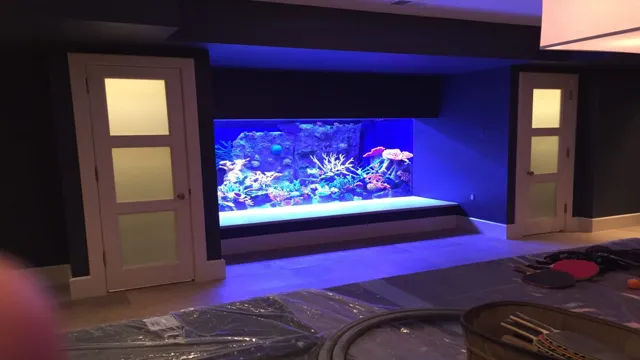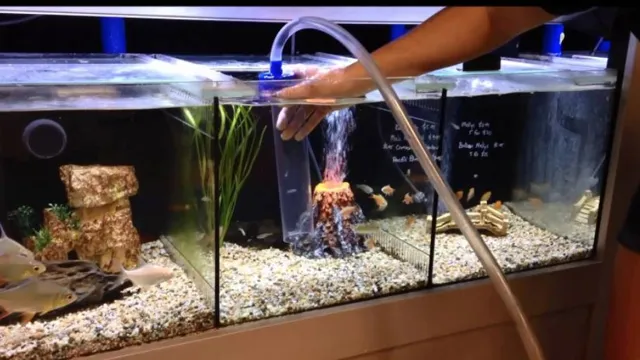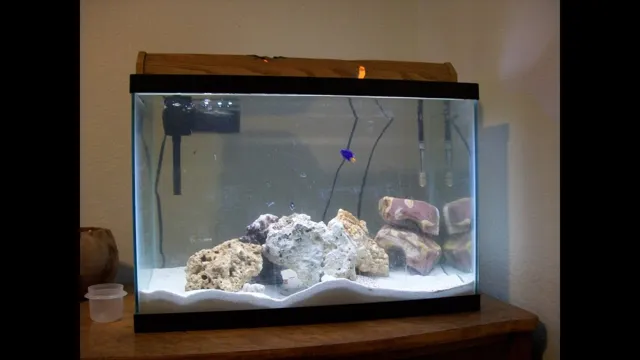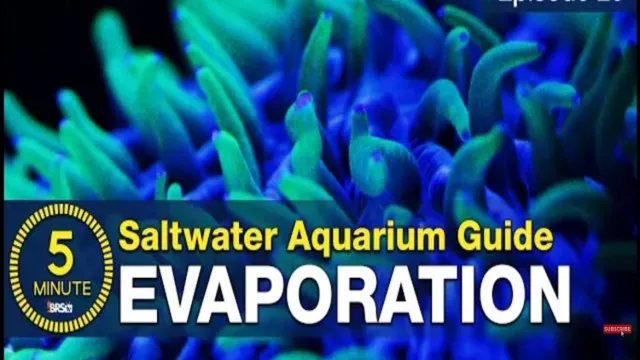Keeping a sump aquarium is a great way to ensure the cleanliness and health of your aquatic pets. However, to maintain the optimum level of water quality, you need to regularly top up the sump aquarium. But the question is, how often should you do it? Well, the answer is not straightforward, as it depends on several factors.
In this blog post, we will explore the factors that determine the frequency of sump aquarium top-ups and provide you with a guide on how to determine the best time to top up your sump aquarium. So, grab your notepad, and let’s dive in!
Understanding Sump Aquariums
“How often top up sump aquarium” When it comes to maintaining a sump aquarium, topping off the water is an essential task to keep the water level stable and prevent any damage to your equipment. The frequency of topping off the sump aquarium depends on various factors such as evaporation rate, aquarium size, and climate. In general, it is recommended to check the water level in the sump aquarium daily and top it off whenever it drops by one inch.
However, if you live in a drier region or have a larger aquarium, you may need to top it off more frequently. It’s important to use freshwater or RO water when topping off the sump aquarium to avoid adding any harmful substances to the tank. By keeping an eye on the water level and topping it off as needed, you can ensure a healthy and stable environment for your aquatic pets and plants.
What is a Sump Aquarium?
A sump aquarium is an aquarium setup that involves a secondary tank (or sump) that is connected to the main display tank through pipes, allowing for the filtration of water outside of the main tank area. This setup is especially popular among serious hobbyists and those who keep larger aquariums as it helps to improve overall water quality and provides a larger volume of water. The sump tank is typically placed underneath or adjacent to the main display tank, and working together, these tanks allow for the removal of waste, debris, and other harmful substances from the water.
With a sump aquarium, you can enjoy a clean, clear tank that is less likely to suffer from problems like algae growth or high nitrate levels. The overall design of a sump aquarium can be customized to meet your specific needs, with options to include different types of filtration, protein skimmers, heaters, and other equipment to create the ideal aquatic environment.
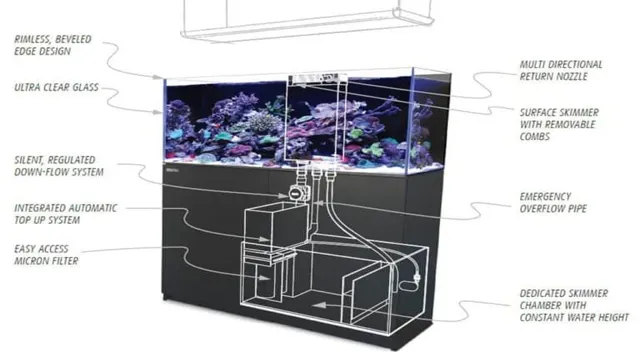
Why Do You Need a Sump Aquarium?
Sump aquariums have become increasingly popular among aquarium enthusiasts and for good reason. A sump aquarium is essentially a secondary tank that works in conjunction with a primary tank to provide additional filtration and water stability. Having a sump aquarium is crucial for maintaining a healthy aquatic environment for your fish and other marine life.
The additional filtration and water flow provided by a sump can help remove waste, debris, and other harmful substances from the water to keep it clean and clear. Sump aquariums also provide additional space for equipment like protein skimmers, heaters, and pumps, which can ultimately enhance the overall health of your aquarium. In summary, if you are serious about maintaining a healthy and thriving aquarium, then a sump aquarium is an essential piece of equipment that you need to consider investing in.
The Importance of Top Up
Maintaining a sump aquarium requires several essential tasks, including topping up the water regularly. One might wonder how often one should top up their aquarium. Generally, topping up saves a lot of effort and money compared to doing a water change often.
Therefore, it is essential to ensure that the water levels in your aquarium remain consistent. The frequency of top-ups depends on the rate of evaporation of your aquarium’s water. The more exposed surface area your tank has, the higher the rate of evaporation.
With that in mind, it’s best to perform top-ups daily or weekly to maintain the water levels. Ensure that you use dechlorinated and temperature-matched water when refilling your tank. Top-ups also help to maintain water quality, leading to healthier and happier fish and plants.
Therefore, it’s essential to keep an eye on the water levels in your aquarium to ensure that they remain consistent.
What is Top Up?
Top up is a term used to describe the process of adding credit or funds to a pre-existing account. It is commonly used within the realm of mobile telecommunications and financial services. The importance of top-up lies in its ability to alleviate the stress of constantly having to make a new account or purchase a new subscription.
With top-up, customers can easily and discreetly add money to their accounts in varying amounts, depending on their needs. This not only saves time and energy but also allows for greater control over one’s finances. Additionally, top-up services are usually easily accessible through online platforms or mobile apps, making it even more convenient for users.
So next time you need to add funds to your account, consider using a top-up service for a stress-free and efficient experience.
Why is Top Up Important for Sump Aquariums?
Top up is an essential part of keeping a sump aquarium healthy and thriving. Sump aquariums are a popular choice for aquarists because they provide a larger space for filtration equipment and help maintain consistent water quality. However, sump aquariums lose water through evaporation, which can lead to changes in salinity and pH levels that could be harmful to the fish and other aquatic life. (See Also: How to Fix a Cloudy Salt Water Aquarium: Effective Solutions and Tips)
Top up is the process of adding freshwater to sump aquariums to replace the lost water due to evaporation. It’s essential to maintain a steady water level in a sump aquarium because it helps the filtration equipment function efficiently and keeps the water parameters stable. Additionally, a consistent water level prevents the pump from dry-rotting and keeps the equipment from being damaged.
Overall, top-up is an essential aspect of maintaining a healthy and stable sump aquarium environment, which is vital for the well-being of aquatic life.
Factors That Affect Top Up Frequency
If you’re a sump aquarium owner, one question you may be asking yourself is how often you should be topping up your tank. Many factors can affect the frequency of your top-ups, including the size of your tank, the water level, and your feeding and filtration habits. For instance, if you have a larger tank, you may need to top up less frequently than with a smaller tank.
Similarly, if you have a lot of fish or feed them often, this may lead to more decomposition and water evaporation, which could increase the frequency of your top-ups. You’ll also want to take note of the water level in your tank and top up as needed to maintain a consistent level. In general, it’s recommended to check your sump aquarium at least once a day and top up as needed.
By staying on top of your top-ups, you’ll ensure that your aquarium’s water quality remains optimal for your fish and other inhabitants.
Tank Size and Water Volume
When it comes to maintaining a healthy and thriving aquarium, understanding the factors that affect top-up frequency is crucial. One of the key factors that determine the frequency of your top-up routine is the size of your aquarium. Simply put, the larger the tank, the less frequently you will need to top-up your water.
This is because larger tanks have a higher water volume, meaning the rate of evaporation is slower compared to smaller ones. Factors such as temperature, humidity, and airflow within your tank can also influence the rate of evaporation. For instance, if you live in a dry and hot area, the water in your aquarium may evaporate faster than usual.
Similarly, if your aquarium has a high level of humidity, you may not need to top it up as frequently. By considering these factors, you can determine the ideal top-up frequency for your tank size and create a healthy environment for your aquatic pets.
Livestock and Feeding Frequency
Livestock and Feeding Frequency When it comes to feeding your livestock, there are several factors that can affect how often you need to top up their feed. One of the most important things to consider is the size and breed of your animals. Larger animals, such as cows and horses, will generally need to be fed less frequently than smaller animals like chickens or rabbits.
Another factor to consider is the type of feed that you are using. Some feeds, such as hay or pasture, can provide more sustained nutrition, while others, like grain or pellets, will need to be topped up more frequently. Additionally, the age and health of your animals can also impact their feeding frequency.
Young animals and those recovering from illness or injury may need to be fed more frequently to ensure they are getting the proper nutrition. Overall, it is important to monitor your animals’ feeding habits and adjust their feeding schedule as needed to keep them healthy and happy.
Humidity and Temperature
When it comes to top-up frequency, two important factors to consider are humidity and temperature. High humidity levels can cause water to evaporate more slowly, meaning that water levels in your tank may last longer. On the other hand, low humidity levels can lead to quicker evaporation, requiring more frequent top-ups.
Temperature can also play a role, as warmer environments can promote faster evaporation. If you’re noticing that you need to top up your tank more frequently than usual, it’s worth checking the temperature and humidity levels in your tank to see if they’re within the appropriate range. By keeping an eye on these factors, you can keep your tank in optimal condition and reduce the need for extra maintenance.
Determining Your Top Up Schedule
When it comes to top-up schedules for sump aquariums, there is no one-size-fits-all answer. The frequency and amount of top-ups depend on factors such as the size of your sump, evaporation rate, and the types of corals in your aquarium. It’s essential to keep an eye on water levels regularly and adjust your top-up schedule accordingly.
Generally, most reef keepers prefer topping up their aquariums every day or every other day, depending on the needs of their specific system. For larger sumps, automated top-up systems can be installed to maintain water levels consistently. Regardless of your top-up method, it’s crucial to make sure you use high-quality top-up water that is free of any contaminants. (See Also: How to Become a Dolphin Trainer at Shedd Aquarium: Tips and Requirements)
By regularly monitoring your sump and adjusting your top-up schedule, you can ensure the health and vibrancy of your reef inhabitants.
Calculating Evaporation Rate
When it comes to maintaining your pool, one of the most important factors to consider is the rate of water evaporation. This will determine how frequently you need to top up your pool with fresh water to keep the water level consistent. Calculating the evaporation rate can be done with a simple formula involving the surface area of the pool, average temperature, humidity levels, and wind speed.
By taking these factors into account, you can determine an estimated amount of water that will evaporate per day. From there, you can schedule regular top ups to ensure your pool stays at the desired water level. It’s important to keep in mind that evaporation rates can vary depending on the time of year and location of your pool, so you may need to adjust your top up schedule accordingly.
By staying on top of this, you can ensure your pool stays balanced and in top condition for swimming and relaxation.
Monitoring Water Level and pH
When it comes to monitoring the water level and pH of your aquarium, one of the most important things to consider is determining your top-up schedule. This means figuring out how often you need to add water to your tank to keep it at the optimal level. To do this, you’ll want to track how much water evaporates from your tank each day and measure the pH level regularly.
This will help you figure out when it’s time to add more water and whether you need to adjust the pH levels as well. Remember, the water level and pH in your aquarium can have a big impact on the health and well-being of your fish and other aquatic life. By staying on top of these measurements, you can help ensure that your tank stays healthy and vibrant.
So, always keep an eye on the water level and pH, and don’t hesitate to adjust your top-up schedule as needed to ensure optimal conditions for your fish and plants.
Tips for Efficient Top Up
As a responsible fish tank owner, you want to ensure that your aquatic pets are healthy and happy. One task that might not be the most exciting is monitoring and adjusting the water levels in your aquarium. Depending on your setup and the size of your sump, you may need to ask yourself “how often top up sump aquarium?” The answer to this question will vary depending on your specific tank and its inhabitants.
However, a good rule of thumb is to aim for a consistent water level that is neither too high nor too low. Be sure to pay close attention to the evaporation rate in your tank, especially if you live in a dry climate or if you have high-powered equipment like protein skimmers. Consider setting a reminder to check your sump water level at least once a week and topping up as needed to maintain a healthy environment for your fish and other aquatic creatures.
By being proactive and monitoring water levels regularly, you can easily prevent potential problems down the road.
Choosing the Right Top Up Method
When it comes to topping up your account, it’s important to choose the right method that works for you. One of the most efficient ways to top up your account is to use a mobile banking app. This method not only saves you time but also ensures that your transactions are secure and convenient.
Another popular method is to use a credit or debit card, which is widely accepted and allows for instant top-ups. However, it’s essential to check for any potential fees or charges before making a transaction. Additionally, using prepaid cards or vouchers is also a viable option for those who prefer not to link their bank accounts.
Overall, the key to efficient top-ups is to choose a method that suits your lifestyle and needs.
Maintaining Consistent Salinity Levels
Maintaining consistent salinity levels in your aquarium can be challenging, but it’s essential for the health of your aquatic pets. One way to ensure a stable salinity level is through efficient top-up practices. A top-up is simply the replacement of evaporated freshwater with freshwater. (See Also: How to Choose Tropical Fish for an Aquarium: Tips and Tricks for Picking the Perfect Species)
It’s crucial to ensure the replacement water has the same salinity level as the tank water to avoid sudden salinity changes. One tip for efficient top-ups is to mix the replacement freshwater with a marine salt mix before adding it to the tank. This method helps maintain a consistent salinity level and prevents sudden fluctuations.
It’s also important to regularly check the salinity level using a refractometer to make any necessary adjustments promptly. By implementing these top-up practices, you can ensure your aquatic pets are living in a stable and healthy environment.
Avoiding Overfilling or Underfilling the Sump
When it comes to maintaining your sump, it’s important to avoid both overfilling and underfilling it. Overfilling your sump can lead to spills and potential damage to your equipment, while underfilling it can cause your pumps to run dry and lead to burnt-out motors. To prevent these issues, it’s essential to regularly top up your sump with the right amount of water.
One tip for efficient top up is to use an automatic top-up system that can monitor and adjust the water level in your sump. Another tip is to keep a close eye on the water level and refill the sump before it gets too low. By following these tips and regularly checking your sump, you can avoid common problems and keep your equipment running smoothly.
Conclusion
In conclusion, the frequency of replenishing the water level in your sump aquarium ultimately depends on the size and type of aquatic life you have in your tank. As a general rule, it’s important to monitor your water levels regularly, and make adjustments as needed to ensure the health and well-being of your underwater ecosystem. So, think of it like topping up your caffeine levels throughout the day – a little bit here and there goes a long way!”
FAQs
What is a sump aquarium and how does it work?
A sump aquarium is a separate tank or chamber that is connected to the main aquarium. It provides additional filtration, increases water volume, and can house equipment such as heaters and protein skimmers. Water from the main aquarium flows into the sump through an overflow system and is then returned to the main tank via a pump.
How often should I top up my sump aquarium with water?
It is recommended to check the water level in the sump at least once a day and top up as needed to maintain a stable water level. This frequency can vary depending on factors such as evaporation rate, temperature, and the size of the sump.
What happens if I don’t top up my sump aquarium?
If the water level in the sump drops too low, the equipment housed in the sump may become damaged or stop working properly. This can result in poor water quality and potentially harm the fish and other livestock in the main aquarium.
How do I ensure the water I use to top up my sump aquarium is safe for my fish?
It is important to use clean, filtered water when topping up the sump. This can be achieved by using an RO/DI (reverse osmosis/deionization) system or a quality water conditioner. It is also recommended to test the water regularly to ensure it meets the appropriate parameters for your aquarium.
Can I automate the process of topping up my sump aquarium?
Yes, there are various automatic top-up systems available on the market that can monitor and maintain the water level in the sump. These systems typically use a float switch or optical sensor to trigger a pump to add water when needed.
How do I clean and maintain my sump aquarium?
Regular maintenance of the sump aquarium is crucial to ensure it functions properly and maintains good water quality. This includes cleaning the filter media, skimmer, and other equipment, as well as removing any debris or excess waste from the sump. It is also important to regularly check and replace any worn or damaged parts.
Can I use a sump aquarium with a freshwater tank?
Yes, sump aquariums can be used with freshwater tanks as well as saltwater tanks. The benefits of using a sump, such as increased water volume and additional filtration, can improve water quality and benefit the overall health of the tank’s inhabitants.


